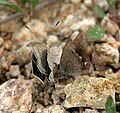
Zizula hylax, 'the Tiny grass blue' is a species of blue butterfly.

Parnassius simo, the black-edged Apollo, is a high-altitude butterfly found in the Himalayas which belongs to the Papilionidae (swallowtail) family.
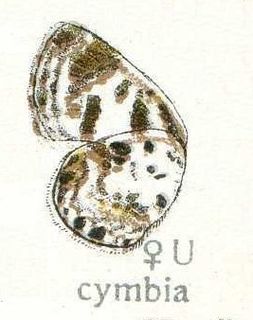
Niphanda cymbia, the pointed Pierrot, is a small butterfly found in northern India, Burma and northern Borneo that belongs to the lycaenids or blues family.
Elkalyce kala, the black Cupid, is a small butterfly found in India that belongs to the lycaenids or blues family.

Chilades lajus, the lime blue, is a small butterfly found in India, Sri Lanka, Myanmar, Taiwan, Hong Kong, Hainan, Mangulam Island, Sulawesi and the Philippines that belongs to the lycaenids or blues family.

Pseudozizeeria maha, the pale grass blue, is a small butterfly found in South Asia that belongs to the lycaenids or blues family. The species was first described by Vincenz Kollar in 1844.

Acytolepis puspa, the common hedge blue, is a small butterfly found in Cambodia, India, Myanmar, Thailand, Yunnan, Taiwan, Sri Lanka, Philippines, Borneo and New Guinea that belongs to the lycaenids or blues family. The species was first described by Thomas Horsfield in 1828.

Lycaenopsis marginata, the margined hedge blue, is a small butterfly found in India that belongs to the lycaenids or blues family.

Lycaenopsis transpectus, the white-banded hedge blue, is a small butterfly found in India that belongs to the Lycaenids or Blues family.
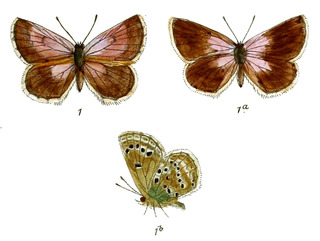
Alpherakya devanica is a species of Lycaenid butterfly found in the Pamirs, Hindu Kush, Karakorum and Tadjikistan.

Nacaduba pactolus, the large four-line blue, is a species of lycaenid butterfly found in Indomalayan realm.

Petrelaea dana, the dingy lineblue, is a species of lycaenid butterfly found in Indomalayan realm.
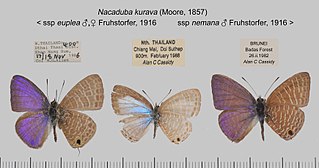
Nacaduba kurava, the transparent six-line blue, is a Lycaenidae butterfly found in Asia and Australia. The species was first described by Frederic Moore in 1857.

Prosotas noreia, the white-tipped lineblue, is a species of lycaenid butterfly found in South Asia and Java.

Nacaduba hermus, the pale four-line blue, is a species of lycaenid butterfly found in Indomalayan realm. The species was first described by Baron Cajetan von Felder in 1860.

Nacaduba berenice, the rounded six-line blue, is a lycaenid butterfly found in Indomalayan realm. The species was first described by Gottlieb August Wilhelm Herrich-Schäffer in 1869.

Prosotas aluta, the banded lineblue, is a species of blue butterfly (Lycaenidae) found in Asia. The species was first described by Herbert Druce in 1873.

Pamiria omphisa, the dusky green underwing, is a species of blue (Lycaenidae) butterfly found in Asia.

Catochrysops strabo, the forget-me-not, is a small butterfly found in Asia that belongs to the lycaenids or blues family. The species was first described by Johan Christian Fabricius in 1793. It is found in Sri Lanka, India, from Sikkim to Indochina and in Sundaland, Sulawesi and the Philippines.
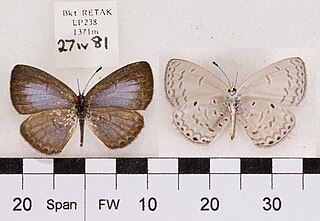
Monodontides musina, the Swinhoe's hedge blue, is a butterfly of the family Lycaenidae. It is found in South-East Asia, including India.



